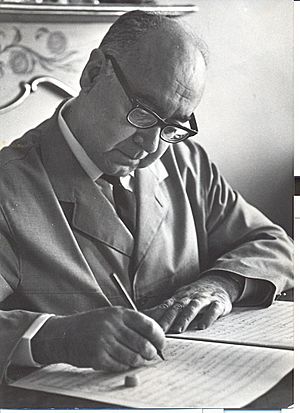Joaquim Homs facts for kids
Joaquim Homs i Oller (born August 21 or 22, 1906 – died September 9, 2003) was a famous Spanish composer. He created many different kinds of music during his long life.
Contents
Early Life and Music Studies
Joaquim Homs was born in Barcelona, Spain. When he was young, he studied the cello until 1922. After that, he taught himself how to compose music. Later, from 1931 to 1938, he also took lessons. From 1930 to 1936, he learned a lot about composing from Roberto Gerhard, who was another important composer.
Some people think of Homs as a Spanish composer, while others see him more as a Catalan composer because he was from Catalonia, a region in Spain. He lived to be 97 years old and passed away at his home in Barcelona.
His Unique Musical Style
Joaquim Homs had a very interesting way of writing music. When he first started, his music used something called free counterpoint. This means he wrote different musical lines that moved independently but sounded good together. His early music also started to move towards atonality. This is a style where music doesn't have a main key or a "home note."
Around 1954, Homs began using the twelve-tone technique. This is a special way of composing where all 12 notes of the musical scale are used in a specific order. It helps create a very modern sound. Even though his music always stayed true to modern styles, his later works didn't always stick strictly to the twelve-tone rules. He kept exploring new sounds and ideas.
Important Musical Works
In the mid-1950s, Joaquim Homs was asked about his most important musical pieces. Here are some of the works he mentioned:
- Duet for Flute and Clarinet (1936)
- String Quartet No. 1 (1938)
- Violin sonata (1941)
- Sonata for oboe and bass clarinet (1942)
- Variations on a popular Catalonia theme (1943)
- String Quartets No. 2 (1949) and No. 3 (1950)
- Poem by J. Carner for voice and piano (1935)
- Four psalms for baritone and chamber orchestra (1939)
- Ten choral responses (1943)
- Choral Mass (1943)
- Rhymes for voice and piano (1950)
Legacy
Joaquim Homs's personal papers, which include his notes and musical scores, are kept safe at the Biblioteca de Catalunya (Library of Catalonia). This helps people learn more about his life and his amazing music.
See also
 In Spanish: Joaquim Homs para niños
In Spanish: Joaquim Homs para niños


